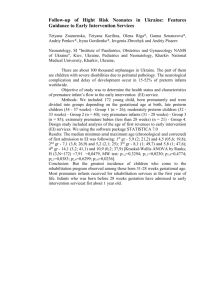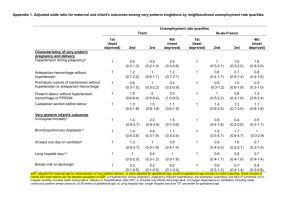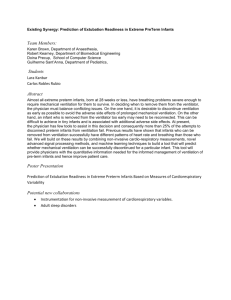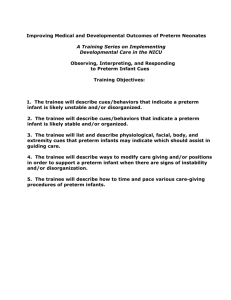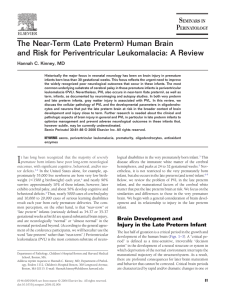The premature newborn infant
advertisement
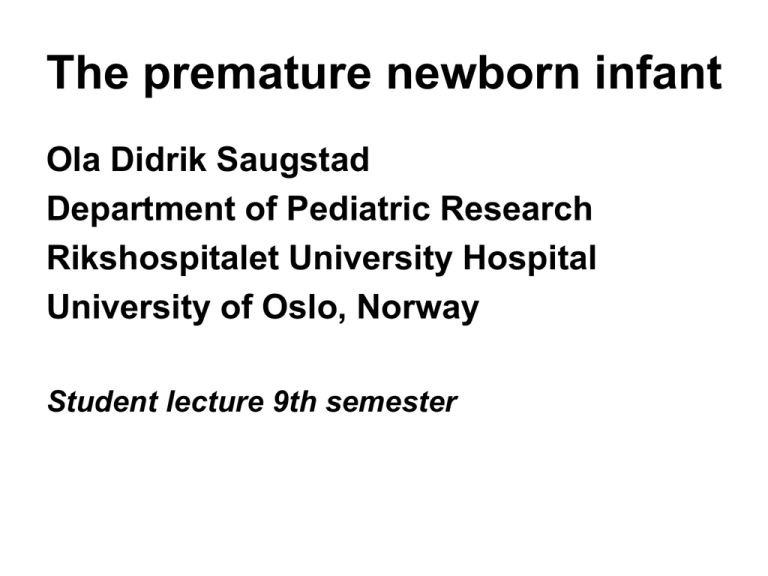
The premature newborn infant Ola Didrik Saugstad Department of Pediatric Research Rikshospitalet University Hospital University of Oslo, Norway Student lecture 9th semester Prematurity • • • • • GA < 259 days (37 weeks) Norway: 5.6% (1988) and 6.5% (1996) < 1.5 kg 0.7-1.0% (528 = 0.9% in 1996) < 1.0 kg 0.3 % (200 =0.3% in 1996) USA: 7% among caucasians 18% among black Preterm infants • Slight 32-36 weeks Feeding and temperature problems, some have immature lungs • Moderate 28-31 weeks Immature lungs, temperature control, feeding problems, apneas • Severe < 28 weeks Immature organ systems, intensive care Slight and moderate approx 3000, severe 200 (0.3-0.4%) per year Terminology • • • • • • Low birth weight < 2.5 kg Very Low Birth Weight < 1.5 kg Extremely Low birth Weight < 1.0 kg Premature < 37 weeks Immature < 28 weeks ELGAN: Extremely Low Gestational Age Newborn < 26 weeks • Small for gestational age < 2.5 percentile General problems in premature infants • Feeding: (IV – Gavage) • Temperature control: (incubator-heated bed) • Respiratory control: apneas, Respiratory support CPAP, Artificial ventilation • Immature lungs – lack of surfactant: Oxygen suppl, Respiratory support (CPAP, ventilator) • Immature brain: brain hemorrhage and cysts • Immunology: risk of infections (antibiotics) • Organ injury (Brain, Eye, Lung, Intestine, Skin • Long term consequences Survival 1940: 50% with BW1500 gram survive 2000: 50% with BW 600 gram survive Birth weight % Survival after 1 year 350-499 g 14 500-799 g 47 750-999 g 76_______________ Medical Birth Registry 1992-96 Survival Gestational age weeks 21 22 23 24 25 26 NFR’s Consensus report 1999 Survival % 0-4 0-12 8-36 12-62 31-79 53-85 Sequels From 1979 to 1994 survival among preterm infatns with BW 501-800 gr increased from 20 to 59%. The percentage of children with severe neurosensory injury was however, unchanged (O’Shea 1997) Injury of ELGANs 1972-1990 < 26 uker < 800 gram Mental retardation 14% 14% Cerebral palsy 12% 8% Blindness 8% 8% Deafness 3% 3% ”Major disability” 22% 24% Survival increased, however rate of injury was constant Lorents JM et al 1998, (meta-analysis including > 4000 children) Injury of preterm infants • Eye ( Retinopathy of prematurity ROP Stage 1-5) • Brain injury (Intracranial hemorrhage (grade 1-4) Periventricular leukomalacia PVL). Immature capillaries (plexus Choroides), hemodynamic changes, intrauterine inflammation • Pulmonary ( Bronchopulmonary dysplasia BPD, Chronic lung disease - CLD) • Intestinal (necrotizing enterecolitis - NEC) Development and pathogenesis of ROP Impact of BPD, Brain Injury & ROP on 18 m Outcome of ELBW Infants Overall probability of a poor outcome @ 18 m (35%) “ A simple count of 3 common neonatal morbidities strongly predicts the risk of later death or disability ” Schmidt B et al. JAMA. March 2003;289:1121- School problems • A Dutch study showed that > 50% with BW < 1500 gram needed extra support at school • No relation between Gestational age and injury • Preterm infants have to be followed-up at least till school age because these problems have a late debut. Learning problems picked up around 8 years ADHD Hyperactivity Intellectual problems (arithmetics, solving problems, cognitive functions) Short term memory Coordination problems Behavioral problems (shy, sport performance, sosialise ) Boys> girs Low Socioeconomic conditions Future challenges • Prevent preterm birth • Understand relation between intrauterine conditions and postnatal injury • Improved nutrition • Improved technology • New drugs (antioxidants, anti inflammatory, etc) • New insight into the needs and the psychological development
